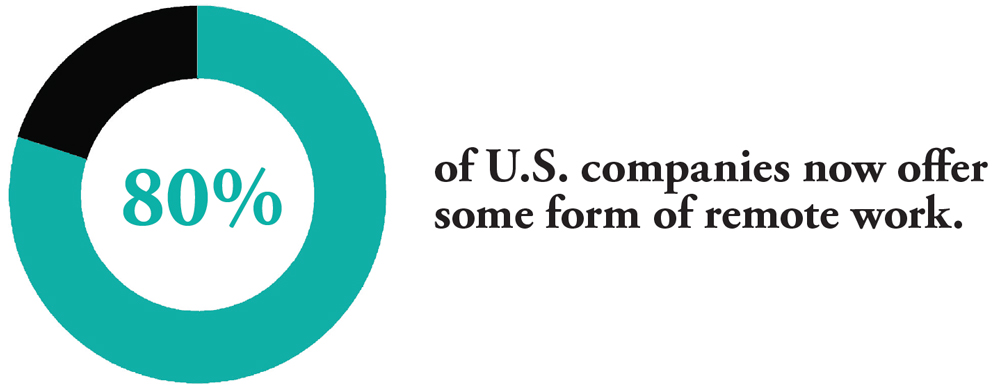Trip.com experiment took place over six months. The findings may surprise you.
In the never-ending debate over remote versus in-office work, a new study shows that the best way forward for all is … both.
More accurately, the study concludes that hybrid work provides the most benefits to both companies and their employees.
Research led by Stanford economist Nicholas Bloom found that employees who work from home two days a week are just as productive and just as likely to earn promotions as their fully office-based peers.
“The study found that hybrid work had zero effect on workers’ productivity or career advancement and dramatically boosted retention rates,” the Stanford Report stated of the six-month-long experiment that was conducted in 2021.
The study was published in the journal Nature and was based on an experiment conducted with more than 1,600 workers at Trip.com, a Chinese company that serves as one of the world’s largest travel agencies. The biggest benefit, the study found, came in the area of worker turnover. When employees shifted from working full-time in the office to a hybrid schedule, quitting was reduced by 33%.

By shifting the workplace commutes to three times per week, resignations fell dramatically among female employees, non-managers and long commuters. Trip.com reported that this reduced attrition saved the company millions of dollars.
“The results are clear: Hybrid work is a win-win for employee productivity, performance and retention,” said Bloom, who is the William D. Eberle Professor of Economics at the Stanford School of Humanities and Sciences and a senior fellow at the Stanford Institute for Economic Policy Research (SIEPR).
Bloom says his findings illuminate a path for other multinational companies: “The study offers powerful evidence for why 80% of U.S. companies now offer some form of remote work, and for why the remaining 20% of firms that don’t are likely paying a price.”
Assisting Bloom in this controlled trial were Ruobing Han, an assistant professor at The Chinese University of Hong Kong, and James Liang, an economics professor at Peking University and co-founder of Trip.com. Han and Liang both hold Ph.D. degrees in economics from Stanford.
How a Study Changed a Company
Trip.com did not offer hybrid work prior to the study. A total of 395 managers and 1,217 non-managers — all with undergraduate degrees and all of whom worked in engineering, marketing, accounting and finance in Trip.com’s office in Shanghai — participated. Most were in their mid-30s. About half had children, and about 65% were male.
Since many were software engineers, the study compared the quality and amount of computer code written by workers in the control group with that of the trial group (hybrid workers). No difference in work quality or volume was found between the two groups.
Bloom says the study should put to bed, once and for all, any lingering concerns business executives have about hybrid work.
“If managed right, letting employees work from home two or three days a week still gets you the level of mentoring, culture-building and innovation you want,” he said. “From an economic policymaking standpoint, hybrid work is one of the few instances where there aren’t major tradeoffs with clear winners and clear losers. There are almost only winners.”
Trip.com executives were so impressed by the study’s findings that they changed their policy and began allowing hybrid work companywide.
The publication of this study comes at a time when many major companies in the U.S. are tightening the screws and issuing return-to-office mandates. The Washington Post and its parent company Amazon, for example, recently notified staff that a return to the office five days a week was mandatory. Amazon’s mandate takes effect in January 2025, while the Post’s edict takes effect February 3.
Post publisher Will Lewis justified the policy by saying it was essential for improving the company and for restoring the “great office energy” that existed before the pandemic. The Washington Post Guild, the union that represents many Post employees, views the policy differently. The Guild says the mandate will be disruptive and will not boost productivity.
Economic development leaders say that this disconnect between bosses and workers will continue to be one of the defining workforce challenges of our time. “Companies are struggling to find the right mix of virtual, hybrid and in-person work to be competitive in the marketplace for the attraction and retention of workers while simultaneously maintaining a company culture and developing employees,” says Tracey Hyatt Bosman, a site selection consultant and managing director with Biggins Lacy Shapiro & Co.
Jennifer Wakefield, president and CEO of the Greater Richmond Partnership in Virginia, says that “the pendulum is officially swinging back the other direction, putting employers back in the driver’s seat where they belong. Many office-using executives have mandated that employees return to the office a minimum number of days during the week. When employees don’t show up, this greatly impacts downtowns and suburban office parks and surrounding areas including restaurants, retail and overall vibrancy of these spaces. It also impacts a company’s ability to engage its employees, maintain a strong culture and navigate the future of work.”
“When employees don’t show up, this greatly impacts downtowns and suburban office parks and surrounding areas including restaurants, retail and overall vibrancy of these spaces.”
— Jennifer Wakefield, President & CEO, Greater Richmond Partnership
Coworking Spaces Replacing Offices
Wakefield hits on an important point: The impact of remote work on office properties. Trepp Inc. reported on November 14 that the Trepp CMBS Delinquency Rate jumped nearly 30 basis points in October, “driven higher yet again by the office sector. Last month, the office rate rose 101 basis points, its largest uptick in 15 months. Furthermore, the Trepp CMBS Special Servicing Rate also leaped 35 basis points in October, driven by office. To begin 2024, the office special servicing rate was 9.74% and has climbed over 400 basis points to its current level of 13.94%.”
As office distress escalates, reports Trepp, expect to see more CMBS loans become problematic. Among them: the $940 million Worldwide Plaza loan in New York; the $90 million Fairview Park Drive loan in Falls Church, Virginia; the $160 million Park Square loan in Boston; and the $39.6 million 3 Beaver Valley Road loan in Wilmington, Delaware.
The grim reality for beleaguered note holders is that suburban office parks were challenged before the pandemic. As remote work became the norm for millions of people nationwide, costly office leases were among the first line items to face the corporate budget axe.
Taking their place are coworking spaces, especially in the suburbs. Coworking Café reported that national coworking inventory increased by 7% in the third quarter of 2024, as 497 coworking spaces were added nationwide, bringing the U.S. total to 7,538.
The fastest-growing markets for coworking space are Nashville and San Francisco. Other hot spots include Atlanta, Miami, Chicago and Indianapolis. The 5 million sq. ft. of coworking space added during the third quarter of 2024 brings U.S. inventory to over 133.5 million sq. ft.

